The typical country house has a big backyard, lots of room for a family, a manicured green lawn, a garden shed and likely a blooming rose bush or two.
But this idyllic image of rural living is part of a complex set of problems holding regional Australia back, as a worsening housing shortage sets in, according to new research.
Low density, detached dwellings dominated regional housing approvals by the end of 2024, at a time when the population was booming and rental vacancy rates were at just 1.7 per cent.

This limited housing diversity in country towns was making it difficult to house critical workers, such as doctors, teachers and the labourers who would drive renewable energy projects, a landmark report from the Regional Australia Institute said.
“The lack of dedicated national and state-level attention to regional housing has led to persistent barriers in planning, financing, construction and infrastructure delivery,” said the Answering the Call for Regional Housing report, released on Thursday.
“Consequently, many regional communities lack the housing diversity and supply needed to support essential workers, accommodate population growth, enable our senior residents to remain in their communities and support our most vulnerable.”
Total housing approvals in the regions fell to 48,570 per annum in 2024, while the population grew by more than 117,000 in 2023.

The low supply and high demand led regional house prices to rise by 62 per cent in the five years to mid-2024, compared to 37 per cent in the capitals.
The housing affordability advantage in the country was waning, the report said.
The worsening squeeze has led the regional think tank to call for 480,000 of the National Housing Accord’s 1.2 million homes to be built outside the cities.
Under the accord, federal, state and territory governments have agreed to the building target over five years.
“The focus of the national housing debate must shift towards increased housing construction in regional Australia,” institute chief executive Liz Ritchie said.

The research also recommended governments establish regional housing agencies, along with the appointment of a federal regional housing commissioner.
Targeted funding for key worker housing should also be increased, while regional construction businesses should be supported to deliver larger and multi-complex dwellings.
“Right now the national housing discourse is dominated by talk of capital city growth and fails to address the chronic housing shortfalls in regional Australia,” Mr Ritchie said.
“However, without a significant step-up in housing supply in the regions, our communities will struggle to attract and retain workers, deliver services and grow economically.”
Australian Associated Press is the beating heart of Australian news. AAP is Australia’s only independent national newswire and has been delivering accurate, reliable and fast news content to the media industry, government and corporate sector for 85 years. We keep Australia informed.





